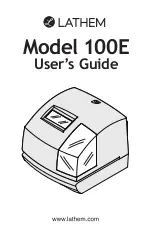
54
MDE-LEDI-1099V4.0
►
Trap Generation:
The product can spontaneously send information to an SNMP Trap server to alert on certain
events. The list of alarms is available by consulting the MIB file of the product downloadable from
this page.
The sending protocol, IPV4 or IPv6 addresses or hostnames (requires a DNS server), ports and
protocols of the Trap servers must then be specified. N.B.: Traps use the identifiers configured
above.
In the SNMP log you will find information about the SNMP server of the product.
It can be read easily with a text editor.
Trap Name
Condition of execution
ntpStarting
The NTP client has restarted. It generally occurs if the product reboots
or if the NTP settings are modified..
newNTPSerSelected
The NTP client has selected a new NTP server to synchronize to. It is
sent during the first synchronization occuring after a reboot, if the NTP
client selects a new NTP server among those availalble or if the NTP
client is synchronizing again after a synchronization loss..
autoNTPSerDetect
The NTP client has just detected a new NTP server that it can use to
send its requests and retrieve the time. This Trap is only sent if the NTP
mode is in automatic, at the start of the product.
noNTPSerDetected
The NTP client could not synchronize because it received no response
to retrieve the time information.
trackingNTPSer
The NTP client is synchronized on the NTP server selected. It generally
fol-lows the alarm neNTPSerSerlected to inform that the synchronization
is done.
lostNTPSync
The NTP client has lost the synchronization. It usually happens if there
is a network issue or if the time servers are all unreacheable.
userLocked
The user forced the product to run in Stand-alone mode. The product is
not
sending
the
alarms
lostNTPSync,
trackingNTPSer,
newNTPSerSelected and ntpStarting anymore as the NTP client is
disable in this mode..
The lists of possible events are listed in Product MIB which you can download on SNMP Settings
webpage (see below). You can configure the SNMP trap server address and protocol version to use in
this section. You can use IPv4, IPv6 or DNS resolved name for SNMP trap server addresses. With
"Mode" settings, you can select which SNMP protocol to use (SNMPv1 /2c /3) or disable trap reporting
to the server.
N.B: Traps use the same credentials than those previously configured and only work if the selected
protocol is correctly enabled and configured in the previous sections
►
The product MIB (Management Information Base) file can be downloaded by clicking on
"Product MIB" at the top of the page.
It can be read with a text editor or by an SNMP client.
Summary of Contents for LEDI
Page 10: ...10 MDE LEDI 1099V4 0 Outdoor clock wall mount...
Page 11: ...MDE LEDI 1099V4 0 11 ENGLISH LEDI POOL Wall mount LEDI WORLD Wall mount...
Page 16: ...16 MDE LEDI 1099V4 0 1 3 5 Ceiling Mounting with bracket for LEDI outdoor clock single face...
Page 18: ...18 MDE LEDI 1099V4 0 1 3 7 Ceiling Mounting with bracket for LEDI outdoor clock double face...
Page 20: ...20 MDE LEDI 1099V4 0 1 3 9 Ceiling Mounting with bracket for LEDI World...
Page 26: ...26 MDE LEDI 1099V4 0...
Page 34: ...34 MDE LEDI 1099V4 0 4 1 1 Configuration date heure...
Page 36: ...36 MDE LEDI 1099V4 0 4 2 LEDICA CLOCK 4 2 1 Settings hour minute 4 2 2 Advanced settings...
Page 37: ...MDE LEDI 1099V4 0 37 ENGLISH 4 2 3 Setting the calendar...















































